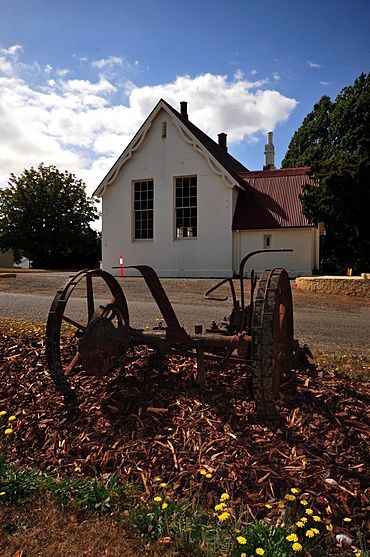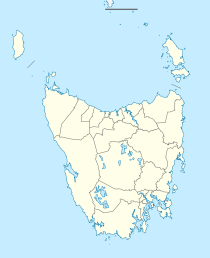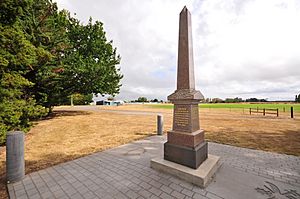Hagley, Tasmania facts for kids
Quick facts for kids HagleyTasmania |
|||||||||||||||
|---|---|---|---|---|---|---|---|---|---|---|---|---|---|---|---|

Hagley Farm School's original 1865 building
|
|||||||||||||||
| Population | 335 (2016 census) | ||||||||||||||
| Established | 1866 | ||||||||||||||
| Postcode(s) | 7292 | ||||||||||||||
| Elevation | 150 m (492 ft) | ||||||||||||||
| Location |
|
||||||||||||||
| LGA(s) | Meander Valley Council | ||||||||||||||
| Region | Launceston | ||||||||||||||
| State electorate(s) | Lyons | ||||||||||||||
| Federal Division(s) | Lyons | ||||||||||||||
|
|||||||||||||||
|
|||||||||||||||
Hagley is a small town and farming area in Tasmania, Australia. It is part of the Meander Valley Council region. You can find Hagley about 5 kilometres (3.1 mi) north-east of the town of Westbury. In 2016, about 335 people lived in Hagley.
This area was once home to Aboriginal Tasmanian people from the Port Dalrymple tribe. They lived here until European settlers arrived and took over their lands. In the 1820s, important people like William Thomas Lyttleton, William Bryan, and Sir Richard Dry received land grants. This led to the first buildings being constructed. Hagley officially became a town in April 1866.
The town is named after Hagley Hall in England, which was connected to William Thomas Lyttleton. Hagley is known for its farming, especially because it has rich, fertile soil near the Meander River. It was also the first place in Tasmania to hold coursing events, which started at Quamby Estate in 1878.
Hagley has several old church buildings. St Mary's Anglican Church, built in 1862, is a beautiful bluestone building. Sir Richard Dry helped fund it and is buried there. Hagley Farm Primary School is Australia's oldest agricultural school. It started in 1865 and now has a 64-hectare (160-acre) farm where students learn about agriculture.
Contents
A Look Back: Hagley's History
Before Europeans arrived, the Hagley area was a camping spot for the Port Dalrymple Aboriginal tribe. This tribe mainly lived and hunted near the Tamar River. Stone tools have been found in the Hagley area, showing their long presence.
By 1830, the Aboriginal people were no longer seen in the area. They had been forced to leave their traditional lands by the new settlers. In October of that year, parts of "The Black Line" reached nearby Westbury. This was an effort to remove the last of the native people from Van Diemen's Land (Tasmania).
Early Settlers and Town Beginnings
William Thomas Lyttleton, William Bryan, and Sir Richard Dry were very important in Hagley's early days. They owned most of the land in the area during the 1820s. Sir Richard Dry's father was granted land in 1819, which helped start the settlement at Hagley. Sir Richard later inherited this land.
William Thomas Lyttleton came from England in 1822. He named his land grant near Westbury 'Hagley' to honor a place in England. He built a home there in 1829. William Bryan, who built the first flour mill in Carrick, also received land in Hagley in 1825.
Lyttleton died in England in 1839. It is believed he gave the land for the village area to the people of Hagley. The first building in the town was a brick church for the Church of England. It opened in 1848 on the road from Launceston to Westbury. By 1849, Hagley also had an inn and a few cottages.
Growing as a Community
Hagley's population grew a lot in the 1850s. A doctor started working there by 1854, and a school opened in the Church of England building in 1855. A postal service also began in Hagley that year. The town got a second hotel in 1857. The Hagley Ploughing Association, the town's first community group, was formed in 1857. A second church, a Methodist Chapel, was built in 1859.
In the early 1860s, a brick school and school house were built at nearby Glenore. A new Church of England church, St Mary's Church of Hagley and Quamby, was finished in 1862. The first church was then used as a school until 1865. A public school opened in 1865. Hagley officially became a town in April 1866. By then, it had many shops, two churches, two schools, and two hotels.
A rail line opened from Launceston to Westbury in 1871. This line helped connect Hagley to other towns. Electricity came to Hagley in 1928. In 1941, the Hagley Flax Mill started working to process local flax. Hagley was officially named a locality in 1968.
Where is Hagley? (Geography and People)
Hagley is located on mostly flat land near the Meander River. It is about 150 metres (490 ft) above sea level. The land is very fertile, with rich soils. This makes Hagley a great place for farming. Before World War II, farmers grew dairy and peas. Now, poppies are the main crop. These poppies are grown for a company called Tasmanian Alkaloids in nearby Westbury. The Meander River forms the northern edge of the area.
In 1911, 611 people lived in Hagley and the surrounding area. By 2011, about 330 people lived in Hagley. Most of Hagley's residents are Australian-born, with 89.1% reporting this in the 2011 census.
Hagley is part of the Meander Valley Council. It is also in the state and federal Lyons electoral areas.
How to Get Around (Roads)
The main road, the Bass Highway (National Route 1), goes through Hagley from east to west. Another important road, Route B54 (Meander Valley Road), also passes through the town. Several other local roads connect Hagley to nearby areas.
In 2001, a new section of the Bass Highway was built to bypass Hagley. This meant that less traffic now goes through the town center.
Hagley's Weather
| Climate data for Westbury (Valley View) | |||||||||||||
|---|---|---|---|---|---|---|---|---|---|---|---|---|---|
| Month | Jan | Feb | Mar | Apr | May | Jun | Jul | Aug | Sep | Oct | Nov | Dec | Year |
| Mean daily maximum °C (°F) | 23.4 (74.1) |
23.4 (74.1) |
21.0 (69.8) |
17.1 (62.8) |
13.8 (56.8) |
10.0 (50.0) |
9.7 (49.5) |
11.9 (53.4) |
14.5 (58.1) |
16.9 (62.4) |
19.4 (66.9) |
21.8 (71.2) |
16.9 (62.4) |
| Mean daily minimum °C (°F) | 8.2 (46.8) |
8.5 (47.3) |
7.2 (45.0) |
4.7 (40.5) |
2.4 (36.3) |
1.0 (33.8) |
0.6 (33.1) |
1.7 (35.1) |
3.0 (37.4) |
4.4 (39.9) |
5.8 (42.4) |
7.5 (45.5) |
4.6 (40.3) |
| Average rainfall mm (inches) | 45.2 (1.78) |
46.7 (1.84) |
47.7 (1.88) |
64.3 (2.53) |
76.6 (3.02) |
85.7 (3.37) |
102.1 (4.02) |
97.2 (3.83) |
81.1 (3.19) |
74.0 (2.91) |
58.2 (2.29) |
55.7 (2.19) |
834.5 (32.85) |
| Average rainy days (≥ 0.2 mm) | 4.2 | 3.7 | 4.3 | 5.4 | 6.7 | 7.4 | 8.9 | 9.3 | 8.1 | 7.4 | 6.0 | 5.4 | 76.8 |
| Source: Bureau of Meteorology | |||||||||||||
Sports and Fun
The sport of coursing first started in Tasmania at Hagley. An event was held at Quamby on June 6–7, 1878. About 500 people, including the Governor of Tasmania, came from Launceston to watch.
Hagley's recreation ground opened in 1902. Before that, sports were played in local paddocks. An Australian rules football club was formed in Hagley around 1895. They played on private land until moving to the recreation ground in 1902. The club was very successful from 1949 to 1953, winning five championships in a row. Sadly, the club closed in 1998.
Hagley's cricket team started in the 1890s. Like the football club, they moved to the new recreation ground in 1902. The ground is still used for cricket, but Hagley no longer has its own team.
Water for the Town
In 1902, Hagley got its first mains water supply from the Westbury-Hagley water scheme. For over a century, the water was supplied without full treatment. This sometimes led to boil-water notices because of contamination.
In 2012, work began on a new $5.5 million water treatment plant in Westbury. This plant now supplies clean, filtered water to Hagley. It opened in June 2013.
Places of Worship (Churches)
Presbyterian Church
A Presbyterian preacher visited Hagley from 1854. Services were held in the Methodist Chapel. In the late 1870s, the old Church of England building was bought by the Presbyterian church. It was torn down in 1878, and a new church was built almost in the same spot.
The new Hagley Presbyterian Church opened on December 14, 1879. It was designed by Harry Conway, an architect from Launceston. The church is a brick building with a Gothic Revival style. By 1973, the Presbyterian group in Hagley was very small. The church building is still in town but is now privately owned and not used for services.
Methodist and Uniting Church
Hagley has a Uniting Church building from 1957. It sits next to the original Methodist Chapel, which was built in 1859. Early Methodist services were held in a farmhouse in the 1840s. Local Methodists raised money for a church in the late 1850s. Land was donated, and a wooden chapel and caretaker's cottage were built. This Methodist chapel opened on March 27, 1859.
The newer Uniting Church building, built in 1957, has a Modernist design with colorful glass. The Uniting Church site was added to the Tasmanian Heritage Register in 2009. The church held its last service on January 31, 2016, due to low attendance and high costs.
=Anglican Church (St Mary's)
Hagley's very first building was a brick church for the Church of England. The foundation stone was laid in 1847, and the church opened in 1848. Sir Richard Dry helped fund it. As the population grew, the people of Hagley wanted their own church parish. Sir Richard Dry offered to pay the minister and give money for new church buildings. This led to the creation of the Parish of Hagley and Quamby.
Sir Richard Dry commissioned an architect to draw plans for a new church. He donated 13 acres (5.3 ha) of land for the church. Dry also paid for the construction of the rectory (the minister's house) and a large part of the church itself. The rectory was finished in 1861.
St Mary's Church's foundation stone was laid on December 10, 1861. The church was built using local bluestone for the walls and freestone for other parts. It is built in a Gothic Revival style. St Mary's was completed and opened on November 26, 1862.
Sir Richard Dry wanted to be buried at St Mary's. After he died in 1869, a memorial was planned. They decided to add a chancel (a part of the church near the altar) to the building. This was finished in August 1871. A tower, spire, and vestry were added in 1932, funded by gifts from Lady Dry and Miss Jane Patterson. The tower is dedicated to Lady Dry.
St Mary's church has copies of famous artworks. These include copies of paintings by Guido Reni and Raphael, donated by Lady Clara Dry in 1857. It also has an organ built in London in 1861.
Learning in Hagley (Education)
Early education in Hagley was often through private teachers. In 1855, a school opened in the Church of England building.
William Bryan and his wife donated land and built a school at nearby Glenore in 1862. This school was fully funded by their gift until 1914. The Glenore school closed in 1941 due to low attendance.
Hagley has one school today: Hagley Farm Primary School. It teaches students from kindergarten to year 6. In 2014, it had 420 students. The school has a 64-hectare (160-acre) commercial farm. This farm has cattle, sheep, and crops. Hagley Farm Primary School is the oldest school in Australia specifically for agricultural education.
The original school building was built in 1865 on land donated by Sir Richard Dry. It has a Gothic Revival style and is still mostly original. In the 1930s, Hagley was chosen to become an "area school." This meant that several smaller, single-teacher schools nearby closed. Their students came to Hagley Area School, which opened on January 30, 1936. The school's lessons expanded to include things like nutrition, construction, agriculture, cooking, and carpentry. Students from other towns were brought to Hagley by bus.
A plan to make the school residential (for students to live there) and expand the farm began in 1939. Building work started in 1941. The school became residential for boys, and its farm grew to 200 acres (81 ha). Students helped build many of the farm's buildings during World War II. After the war, from about 1948 to 1955, the school welcomed child migrants from Belgium, Greece, and the United Kingdom. The school has been known as Hagley State School, Hagley Farm School, and since 1976, Hagley Farm Primary School.
Old Buildings to See
Hagley has many 19th-century buildings. Some are listed on the Tasmanian Heritage Register, which protects important historical places.
- Hagley House: This is a two-story brick house built in the Georgian style. It is about 1.5 kilometres (0.93 mi) from the town center. William Lyttleton started building it before 1848.
- Hagley Mill: This historic site is about 1 kilometre (0.6 mi) south of Hagley. It is special because it might be the only mill in Australia that was powered by horses. The mill and other buildings date from 1830 to 1840. Its unique eight-sided wheel house was designed to fit the horses and their driving system.
- Quamby House: Sir Richard Dry built Quamby House in 1838. It was mostly built by convict labor using local clay bricks. It has an American Colonial style with a long stone veranda. Today, Quamby is a tourist attraction called the Quamby Golf and Country Club. It has a 9-hole golf course.






